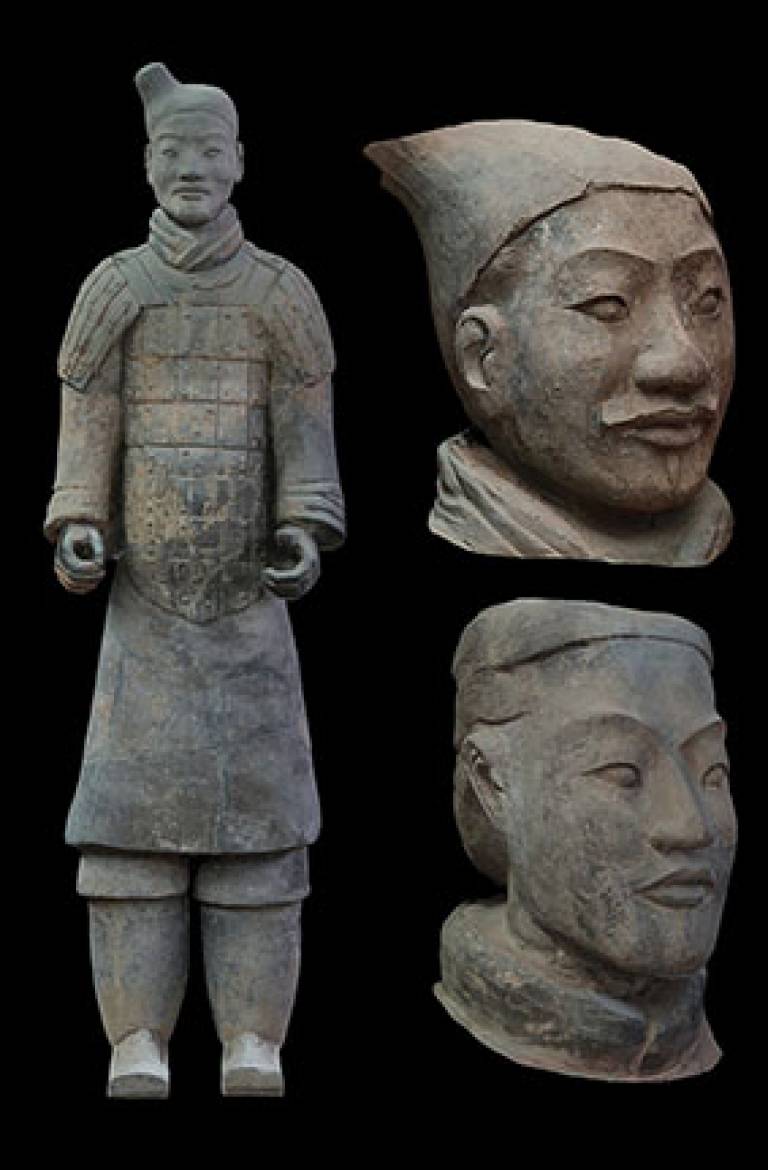3d models and the faces of Qin?
13 June 2014
3D textured meshes of a whole warrior and two other warriors' heads.

We're excited to have just had another paper come out (you can find it in the Journal of Archaeological Science here) that describes how we have been building 3d models of the terracotta warriors and using them not simply for nice documentation and presentation, but also to try to address some thorny analytical questions too. The 3d modelling technique itself is an extremely promising one (derived from the fascinating filed of 'computer vision') which is fast becoming popular in archaeology since it was first introduced a couple of years ago (our project can claim to be an early adopter, but the first archaeological application is probably this one). I'll come back to the technique itself below, but the background rationale for why we might find such models useful for the Imperial Logistics project is also interesting.
One of the underlying obsessions of our project is with the 'shape' of objects found in the First Emperor's mausoleum complex and what insights might be offered by very fine-scale shape differences in otherwise seemingly similar weapons and warriors. For the bronze weapons, this lead Janice Li to take a series of careful measurements at known points on the weapons (some people call these anchor points 'landmarks') and compare these statistically. These measurements proved to provide some really useful clues about both workshop practice and the possible ways in which workers operated inside the army pits. Marcos and Janice have both blogged about this here and here (with further references to published papers for those who are interested).
Turning from the weapons to the warriors however, things get even trickier if we want to talk about shape, as it is far less obvious what 'landmarks' on the warriors we can choose (the corner of a warrior's eye perhaps, the tip of their ear?), and what the scale of our analysis should be (a single body part, or the whole warrior in one go?). But it is worth the effort to come up with an appropriate research strategy because the kinds of questions we might want to then ask are really fun! For example:
- Can we see the impact of different workshop cells in the shape details (the 'micro-style') of different warriors, in the same way as we can identify them in the bronze weapons? If we can make such identifications, then we'd also be hoping to look at whether we can map such workshop variations across the pit itself, as I talked about in a previous blog.
- Were the warriors portraits of real living Qin individuals as some have suggested (e.g. either soldiers in the living Qin army or workers at the mausoleum)? Or are they merely meant to look plausibly individual via a sort of Mr Potato Head strategy of adding in different moustaches, ears, clothing, hair-styles, etc.? Where does the obvious technological standardisation of the warrior production methods stop and the desire for individualism start?
The 3d modelling we have been using also constitutes something of a mini-revolution in archaeological recording that will have impacts on how we all document everything from whole archaeological landscapes, to individual sites and excavation trenches to artefacts. Archaeology was quick to adopt 2d mapping (GIS) technologies from the end of the 1980s, but now 3d approaches are fast becoming popular. There are a variety of different means by which people can capture 3d information, including both the use of laser scanners and of photograph-based techniques that fall under the umbrella of 'photogrammetry'. What we are doing is a recent variant on photogrammetry probably best termed 'Structure-from-Motion' or SfM. SfM models are made in several steps, involving photo-capture, image-masking, camera alignment and point-cloud construction (with further meshing and texturing if desired). The key to making the technique work well is to achieve considerable overlap between photographs as this allows software to identify shared features visible in multiple images (the 'motion' of moving from one camera perspective to another). Such a technique is amazingly portable and fuss-free....no more fancy equipment and need to wait for guru operators! One of its further advantages is that it enables 'citizen science', as member of the public can participate in research data collection by either helping with the photo capture phase itself or by improving the end result by isolating the object from its background on each image prior to model-building (two good examples are here and here). There are also opportunities for people to upload their own photos and go through the entire modelling steps themselves, though such online solutions do not yet produce as crisp a final product as offline, user-guided approaches (see here and here).
Another big advantage is that we can now collect large samples of artefacts and compare them in minute 3d detail. So we hope that SfM heralds a brave new world of better typology and taxonomy for archaeologists, art historians, palaeontologists and biologists alike. Our recent paper offers a first stab at how such typological comparison might be achieved, and looks at the ears of a sample of the warriors from pit 1. Ears are fascinating, truth be told. The are so individual in real human populations that they are often used as biomarkers (e.g. in criminal forensics where people sometimes analyse ear-prints in the same way they might finger-prints). Looking at the terracotta warrior ears might therefore allow us to say something about the question of individualism and portraits that I mentioned above. However, comparisons of artistic renderings of ears are also famous (alongside hands) in art history as being one of the best examples of 'Morellian' method. The latter was a method devised by the 19th century Italian art critic Giovanni Morelli who famously argued that if we really want to distinguish different artists, for example different painters, in otherwise unsigned works, we need to look really carefully at the details of how they habitually rendered incidental features such as hands and ears, because these features are more likely to be an unconscious signature of the artists' personal style. Hence, if we are interested in the workshop organisation behind the warriors, looking at incidental ear style is a useful way forward. As you can imagine, the variation we observed in the terracotta ears might either be to do with real life individualism or be due workshop practice or both. It may well be hard to disentangle these things, but it is exciting to try. Anyway, here's a viewer that will work with most modern browsers on desktops/laptops (for those using a Safari browser, you may be able to enable this via your settings) and which gives you a taste (low-res, alas) of what the models look like!

Andrew Bevan is a Professor at the UCL Institute of Archaeology and is the Deputy Director of the Imperial Logistics Project.
 Close
Close

